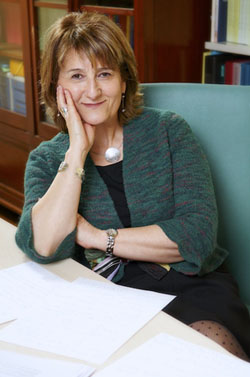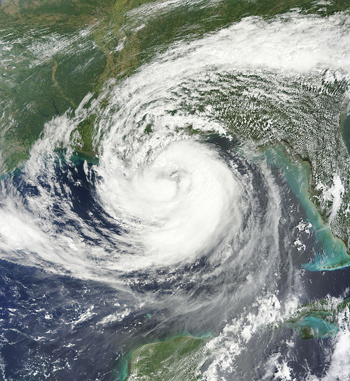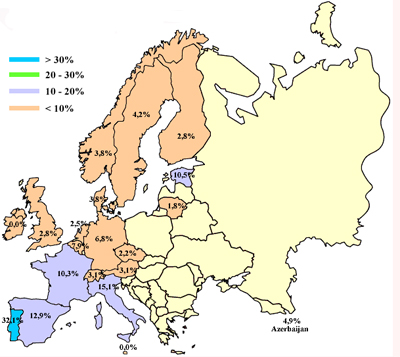Career interview: President of the European Mathematical Society

Marta Sanz-Solé.
Plus first encountered Marta Sanz-Solé at a drinks reception, giving exactly the kind of speech you want while you're sipping wine and nibbling canapés: short and funny. Her audience were mathematicians attending the 6th European Congress of Mathematics, which took place in Krakow in July, and Marta was speaking in her role as the President of the European Mathematical Society (EMS). Definitely a great interview subject, we thought, and we were lucky. Despite an incredibly busy schedule — the EMS organised this 1000-people-strong conference — Marta found time to talk to us about her career as a research mathematician and figurehead of Europe's representative body for mathematics.
Naive beginnings
Marta first became interested in maths at school. "I was quite successful in solving problems. I was also very much motivated by abstract thinking, by logic, by philosophy, by science in contrast with technology. But I was really naive and ignorant! At that time, I met some excellent teachers who encouraged me to consider studying mathematics at university, and I followed their advice. I felt very excited with such a challenge."
Initially Marta had trouble choosing between maths and physics as a degree subject and eventually decided to combine both. "But mathematics was so demanding and I was also taking courses in playing the piano, so [a combination of maths and physics] was too much." Marta stuck to mathematics only and also carried on with her music, something she still enjoys today.
And she's not the only mathematician to do so. Many are interested in music and play instruments. Is it true that there are parallels between the two areas that make music particularly attractive to mathematicians? "Like mathematics, the language of music is also very abstract," says Marta. "It's more abstract than literature or even poetry. So there certainly is a connection. And moreover there is a lot of mathematics underlying music. But I personally am more interested in music as an art, rather than the analysis of the underlying structure. I don't take it as an extension of my profession, but as an extra activity to enjoy art."
After finishing her degree Marta was faced with a question that confronts many who'd like to take their maths further: should I do a PhD? Her other option, becoming a highschool teacher, offered more certainty. "I knew very well what a career in a high school was, but it's not clear for a student what doing a PhD and carrying out research is like. But eventually I decided to embark on a PhD programme. I thought that becoming a teacher meant having my future determined, while research could give me more opportunities to change direction [later on]."
Doing a PhD did come with a few challenges. "For me it was a very nice experience, but it is true that it can also be very stressful. First there is the uncertainty: your supervisor gives you a subject [to work on]. You then have to solve a problem and you know you have to solve it in a fixed amount of time — that's a challenge. Also, this comes in a period of your life in which you have other problems to solve, especially [if you're from my generation]. Nowadays young people may postpone building a family, but when I finished my studies I started to live with my partner, we wanted to have a baby and so on. It was a difficult time." But for Marta the rewards outweighed the stress. "Once your realise that you've proved your first theorem you are so excited! I was really enjoying that and I am very happy about my life. I would like to change some things of course, but not the direction of my career."

The weather is a result of a complex web of interacting factors which are hard to capture in a mathematical model. This image shows hurricane Isaac over the Gulf of Mexico in August 2012.
Experimental maths
Marta did her PhD in an area called stochastic analysis and that's the area she still works in today, as a Professor at the University of Barcelona. It's about bringing randomness into the models we use to describe the world around us.
If you're looking at a simple physical process, say two colliding billiard balls, you can often use an equation, in this case Newton's second law of motion, to predict what is going to happen to the two balls after impact. But in most real-life situations, such as predicting the weather or the behaviour of the stock market, things aren't that clear-cut. These processes are subject to all sorts of events that, to all intents and purposes, happen randomly. To account for these and other uncertainties, stochastic modelling combines clear-cut equations with random processes — metaphorically speaking the cast of a die — to make room for such random fluctuations. Instead of a single prediction for tomorrow's weather, say, you might then get a whole range of possible weathers, together with probabilities telling you how likely each one of them is. (You can explore stochastic models in the Plus articles Backgammon, doubling the stakes, and Brownian motion and Keeping track of immunity.)
Marta works mostly on the theoretical side of stochastic analysis. But still, it's the applicability of her work that attracted her to the area. "There is a part [of stochastic analysis] which is very much related to mathematical analysis: it's very precise. On the other hand it is also very experimental, more than other areas of mathematics like algebra and geometry: you think of models, then you discard them if they don't work, or you modify your hypothesis. Maybe this more experimental aspect is what I like. It is abstract, but you can really put your hands into the problem and get something out of it."
Marta's move into a job after her PhD was very different to what it is for budding mathematicians today, who often spend time abroad and travelling to conferences. She graduated from her undergraduate degree in 1974, one year before Spain's dictator Fransisco Franco died and the country began its transition to democracy. "At that time Spain was scientifically quite underdeveloped. Although I got a very good education at my university, at [the time I began my postdoctoral work] there weren't any funding agencies. So my first trips to conferences I had to pay myself. The system of grants only arrived in Spain at the end of the 1970s. So at that time it was quite difficult to get a postdoctoral job abroad. Most of the people in my country stayed at home. We are the generation that has developed science in Spain as it is now and we put a lot of effort into it."
Eventually research in Spain took off and Marta moved on to a permanent job. Then, after a couple of job changes, she arrived at the University of Barcelona, becoming a professor in 1986. A professor's job is a combination of teaching and research. What does she like best? "I like teaching very much, this is my contact with reality. But research is also fascinating. I very much understand the satisfaction someone feels who builds a very nice building or composes some music. Mathematics is the same. When you see that you get results you have this feeling of having created something. Of course, research has a frustrating side, but I must say that I have been successful. I have very good memories from every stage of my career."
Being a President
These days Marta has a reduced teaching load to make way for a prominent role in European mathematics: since 2011 she has been President of the European Mathematical Society (EMS), a learned society representing mathematicians throughout Europe and promoting the development of all aspects of maths. Her interest in this aspect of mathematical life stems in part from her close involvement with building mathematics in Spain. But it also comes from a thirst for variety. "I am quite a multi-tasker. I love mathematics but I am not the kind of mathematician who starts her day doing mathematics and goes to bed doing mathematics. I like to be involved in different aspects of life."
Before becoming President Marta had already spent eight years on the EMS Executive Committee and she found the work fascinating. "For me it was a fantastic experience because I learnt what is going on in mathematics around Europe from very different perspectives, not only research, but also things like scientific policy, gender issues or raising public awareness [of mathematics]. Another thing that fascinated me, because I am a good observer, was to see how people with very different views and cultural backgrounds could discuss things and eventually agree. It's a very interesting exercise to observe an Italian and a Finnish person [interact] — they are quite different."

Marta Sanz-Solé speaking at the opening of the 6th European Congress of Mathematics. Behind her is a quire from the Jagiellonian University in Krakow.
As President of the EMS Marta's tasks are complex and varied. There's a jumble of committees — a committee on applied mathematics, a committee on women in mathematics, on raising public awareness, on electronic publishing, to name just a few — and these need to be coordinated and guided. "The EMS also has a publishing house and although it is structured as a company, I am the chair of its board. So I have to know what is going on, I have to take decisions."
Then there is the all-important connection to politics. "I try to be quite active in controlling the relationship between the EMS and the EU political bodies. At a national level it's difficult for mathematical societies to have access, to be influential in scientific policy. The EMS has better chances. This is a very important activity of the EMS."
So what kind of challenges are facing mathematics at the moment? "As a subject I think we are in a very good position. We are much better acknowledged by other disciplines; much better-known than before. The image of the mathematician as a crazy guy or crazy girl is changing a lot, at least this is my impression. But we have a very serious problem of funding at the level of the European Union. [Most of] the science funding instruments that the European Union has provided so far only suit disciplines that need large infrastructures and large networks. This is not the way mathematicians work. Of course we need to collaborate with other people, but we don't need big networks, like for example the life sciences, which have labs, theoretical researchers, experimentalists and companies that implement their products. Of course this makes maths much cheaper than other disciplines, but still we need money. Communities like physics and the life sciences are very big so they have been able to create lobbying structures. For us it's not so easy because we are small. But this is one of the roles of the EMS: increase lobbying in Brussels, be more professional, create better structures, and depend less on volunteer work. To address such issues you need some background — good will is not enough, you need skills."

Percentage of female mathematics professors in 2005. From Statistics on women in mathematics, a report compiled by Catherine Hobbs and Esmyr Koomen. Click here to see larger image.
Women in maths
One issue that constantly gnaws at mathematics, and that can't be ignored speaking to the first female President of the EMS, is the gender imbalance. Although things have been improving over the last twenty years or so, and although there are considerable variations between European countries, women are still under-represented amongst senior researchers. At a panel discussion that took place at the European Congress of Mathematics the day before we spoke to Marta, Marja Makarow, former Chief Executive of the European Science Foundation, reported that if we keep on at the rate we're going, it will take 400 years until 50% of professors in science, technology, engineering and maths subjects are female.
Some people call for intervention, from mentoring for female students to more drastic measures such as gender quotas for bodies that have financial or hiring power, or ear-marking professorships for women. The latter has been tried in Norway and Sweden, but was eventually ruled unlawful by the European Free Trade Association. But Marta does not agree with the interventionist approach. "I am more in favour of [letting things evolve naturally]. Of course there is the problem that in a very important point in your career you would like to have a baby and build a family. So the weight a woman carries on her shoulders is much higher than for a man, even if your partner helps you. Of course helping women at that period in their career by having specific programmes [would be useful]. But to make specific efforts to attract women — I don't like that idea. I would feel very uncomfortable to have a position because I am a woman. For me that would be discrimination."
Our final question for Marta is one we ask all our career interviewees. What would you say to somebody at school who is toying with the idea of taking up a career like yours, in her case as a mathematical researcher? "I'd recommend it. Of course you need to be aware that it's not an easy career. But easy and difficult depends on your skills and on your patience. So if you feel like it, then just go ahead."
About the author
Marianne Freiberger is Editor of Plus. She interviewed Marta Sanz-Solé at the European Congress of Mathematics which took place in Krakow in July 2012.